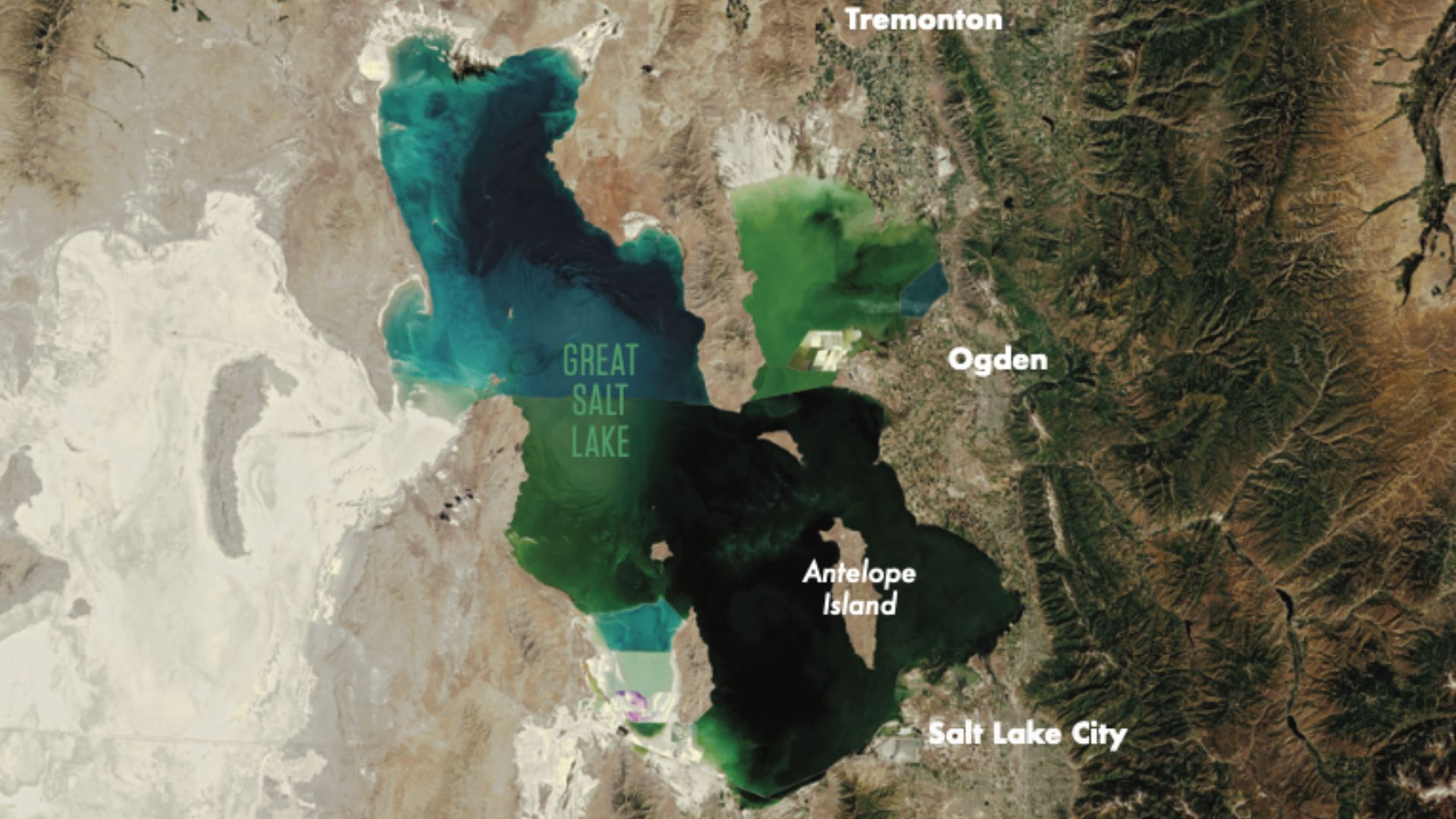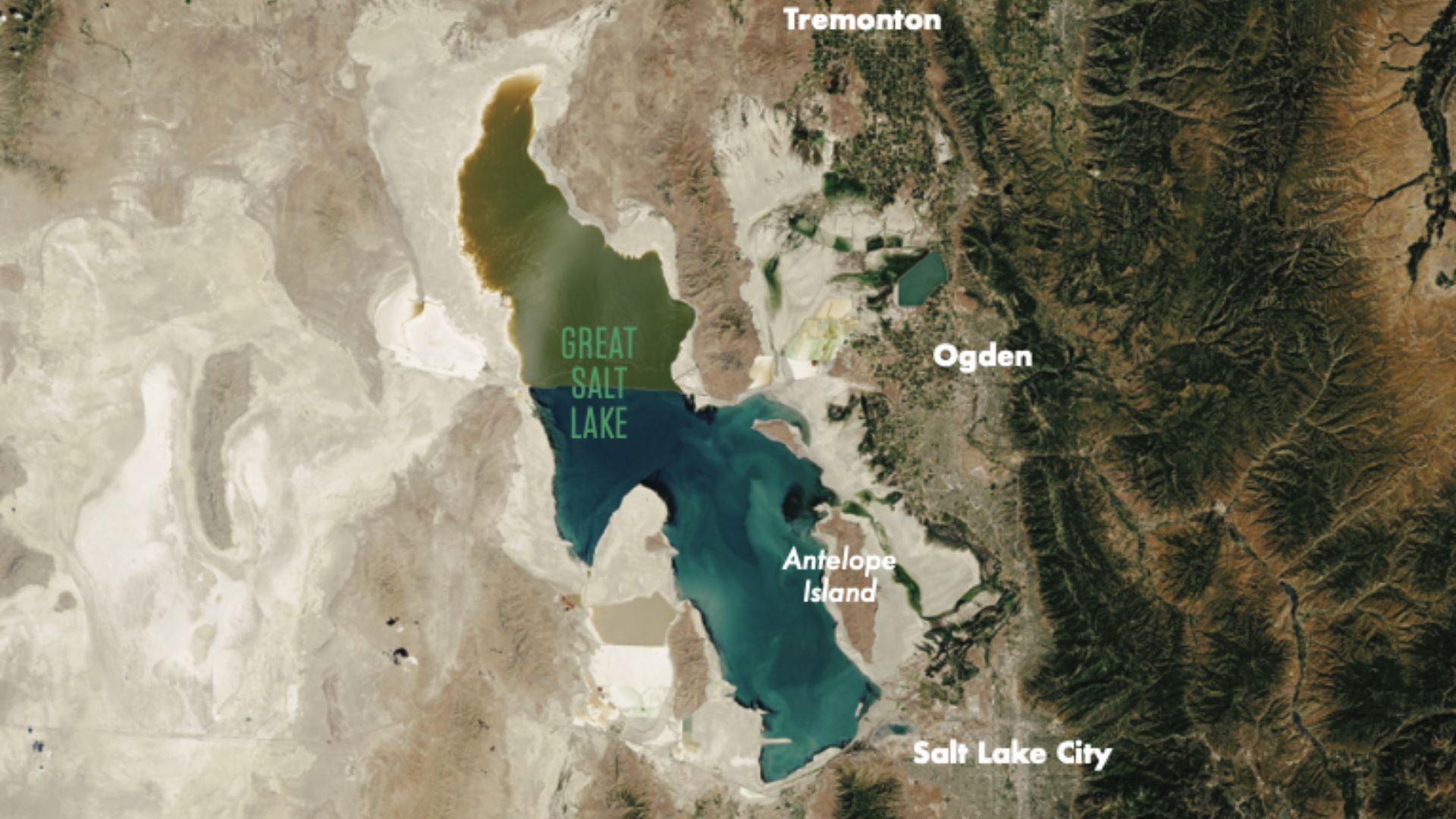My senior year of high school, my friends and I went out to the salt flats of the Great Salt Lake to watch an April sunset. We danced around on the crusted crystal salt, chasing clouds of brine flies and staring in awe at the sun, resting complete and red on the dusty pink horizon. I wore my favorite shoes that day, and the salt got into them in a real stubborn way. Despite my best scrubs, the shoes were forever altered, forever salted.
I don’t remember the first time I heard that the lake was dangerously dry.
I do remember driving up American Fork Canyon to Tibble Fork Reservoir in the summer of 2021, the car piled full of sliced watermelon, friends, and floaties, and feeling completely shocked when we came up over the hill and I saw how low the reservoir was. I scrambled down a sloping hill to reach the water. It must’ve been at least 5 feet lower than it had been the previous summer.
That same August, on a roadtrip to southern California, I had that same feeling seeing the Virgin River almost completely dried up, just a thin little trickle of pale water weaving underneath rocks that had once been wholly submerged.
The drought we’ve been in for the past couple of years isn’t the first time Utah has experienced this type of scarcity. For close to the entirety of 2003, nearly 100% of the state was classified as suffering from a category D3 drought, which the United States Drought Monitor (USDM) describes as extreme. The possible implications for extreme drought listed on the USDM website are significant crop losses and water shortages.

Water levels at the Great Salt Lake June 1985. (NASA Earth Observatory)
As a state with a mostly arid climate, Utah is accustomed to fluctuations in precipitation and drought. But the drought in 2003 never completely ended, and in 2021, it got significantly worse, as shown by the USDM data. For more than 14 consecutive months, at least 80 percent of the state was constantly in D4 level drought. According to the USDM, the possible implications of D4 drought are severe crop loss and water shortages in natural resources that lead to emergencies. And in 2021, the drought did lead to emergencies and Utah reservoirs were dangerously dry. This winter, things finally took a turn for the better.
According to NASA’s Earth Observatory website, the western United States is experiencing winter oceanic storm La Niña for the third year in a row, and Utah has consequently received an unexpected amount of precipitation. All this rain and snow has added to Utah’s snowpack, and the drought across the state has been diminishing as the ground drinks up the moisture. Since November, the percentage of the state in extreme drought has dropped a relieving 50.7%, from 51.7% to a mere 0.98%, as per the USDM. In the same period of time last winter, the extreme drought decreased from 78.7% to 33.3%. During the peak of the drought the previous November-March, it actually increased by 3%- from 87.2% to 90.2%.

While the drought seems to be seeing significant improvement, it’s hard to say if it’ll be enough to pull us completely out of the danger zone. I spoke with Ryan Rowland, the Data Chief at the US Geological Survey Utah Water Science Center, who told me he regularly attends drought webinars with many state and federal agencies focusing on drought. “The general feeling is this is a big step in the right direction,” he told me, “but it’s likely not going to completely break this drought we’re in. We have a lot of catching up to do because we had such poor water years in 2021 and 2022. The deficits in some reservoirs are significant. We need to fill those reservoirs up.”
Even though the soil moisture and reservoir water levels have been increasing this winter, this seasonal ebb and flow is nothing out of the ordinary. Each spring and early summer, the reservoirs and lakes fill up as the snow melts into the rivers. In summer and early fall, the water evaporates in the heat. Through the winter, the snow comes, and the cycle continues. And so, despite the slow-climb out of drought in the last year for the rivers and reservoirs, the Great Salt Lake reached a historic low in November of 2022, with its surface level being 4,188.5 feet, and its area less than 1,000 square miles, according to the US Geological Survey website.
“One thing that’s clear is that the lake is truly very dynamic,” Rowland said, explaining that a data record for the Southern half of Great Salt Lake has been diligently kept since 1847, and the lake has seen dramatic fluctuations during that time. The lake set a record low in 1963, and then after a particularly wet period in the 80s, the lake flourished and reached a record high, with its area being around 2,300 square miles. But now, since the 80’s, the lake has shrunk by close to 300%.
Where is all that water going? According to an article by Wayne Wurtsbaugh, Craig Miller, Sarah Null, Peter Wilcock, Maura Hahnenberger, and Frank Howe published by Utah State University, the Great Salt Lake is in a terminal basin, which means that all the water flowing into the lake, stops in the lake. The lake only loses water through evaporation. The data in the article show that there hasn’t been much of a change in water supply since the pioneers arrived in 1847, but increasing land developments and river diversions over the generations since then have created a dangerous decline in the amount of water that makes it all the way to the lake. The net river inflow to the lake has decreased by a staggering 39% over the past 176 years. In other words, the Great Salt Lake’s emergency is human-caused.
In the State of Utah, all water is public property, according to the Utah Division of Water Rights, and those who’ve received water rights from the state can divert water from a source for beneficial use. A water right defines how much water can be diverted, from where, and for what purpose. But water rights don’t outline or specifically consider downstream effects. That means water rights don’t protect Great Salt Lake, and so businesses and development projects legally only need to worry about whether or not there is available water flowing down the stream, according to the Utah State University publication. Irrigation, mining, and residential usage takes significant amounts of the water headed for the Great Salt Lake, and this lack of regulations could have catastrophic effects.
In addition to the Great Salt Lake’s economic, cultural, and ecological significance, its drying-up is bad for the health of the population. According to the Western Hemisphere Shorebird
Reserve Network’s page on Great Salt Lake, the heavy metals, pharmaceuticals, detergents, and other toxins in our waste find their way underground, into the water supply, and down into the lake. As the lake dries up, more and more of those toxins in the lakebed dusts become exposed. When the wind picks up, it blows those dusts around the surrounding valleys and we breathe it all in.
The Utah Geological Survey says that the rapidly increasing population in Utah, in tandem with continued decline in snowpack and streamflow due to climate change, is not sustainable for the state. It’s hard to parse out exactly how much of the water use in Utah is residential or institutional versus commercial or industrial, because Utah reports water use in Gallons Per-Capita Day, or GPCD: the total water use in an area divided by the residents there. The important thing, though, is that most of us could take shorter showers, avoid small loads of laundry, turn off the sink while we’re washing our dishes or brushing our teeth, and run our sprinklers in the evening after the heat of the day. We could all use water more consciously and responsibly.
So yes, the snow and rain this winter has been immensely beneficial. And yes, while the drought will recede as the snow melts this spring, it will worsen again over the summer, like it does every year. Much of the runoff from this winter will never reach the Great Salt Lake, and the long-term drought may only intensify.
Our actions now will largely determine how much.




